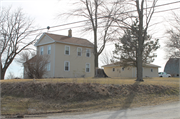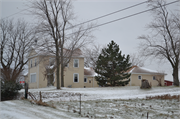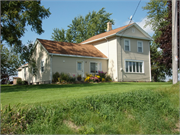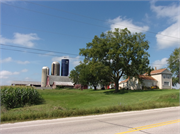Property Record
1008 200TH AVE
Architecture and History Inventory
| Historic Name: | House, Lewis C. and Mary Williams farmstead |
|---|---|
| Other Name: | |
| Contributing: | |
| Reference Number: | 227200 |
| Location (Address): | 1008 200TH AVE |
|---|---|
| County: | Kenosha |
| City: | |
| Township/Village: | Paris |
| Unincorporated Community: | |
| Town: | 2 |
| Range: | 21 |
| Direction: | E |
| Section: | 7 |
| Quarter Section: | SE |
| Quarter/Quarter Section: | NE |
| Year Built: | 1890 |
|---|---|
| Additions: | |
| Survey Date: | 20192013 |
| Historic Use: | house |
| Architectural Style: | Gabled Ell |
| Structural System: | |
| Wall Material: | Aluminum/Vinyl Siding |
| Architect: | |
| Other Buildings On Site: | Y |
| Demolished?: | No |
| Demolished Date: |
| National/State Register Listing Name: | Not listed |
|---|---|
| National Register Listing Date: | |
| State Register Listing Date: |
| Additional Information: | 2019- "This farmstead stands on the west side of 200th Avenue (USH 45), about one mile north of the town of Paris in the SE quarter of Section 7 in Paris Township. The property consists of eight buildings, including a house and garage, dairy barn, and several auxiliary farm buildings. The property was previously inventoried in the AHI as the Lewis C. and Margaret Williams Farmstead (22700-227206), but Lewis C. and Mary Williams are more appropriately associated. "Plat maps indicate the property was homesteaded as early as 1861. In 1861 the property was part of a 92-acre farmstead owned by William Eade Jr (1830-1906). He emigrated from England with his parents, who resided on an adjoining 60-acre farm. In 1854, he married Elizabeth Meredith (1836-1876) in Paris Township and they had eight children. In addition to farming, his business was real estate and loans (FindaGrave.com). In the 1873 map, the farmstead’s parcel had been split and Louis (sic) Williams Jr (1820-1903) owned this 48-acre portion. At the time, his father owned 158 acres across the road in Section 8. Their family emigrated from Wales in 1842. Upon arrival, Lewis Williams Sr (1789-1873) “cast his lot with the pioneer settlers of Kenosha County” and purchased 80 acres of land from the government in Section 28. He “spent most of his life [on his farm in Section 28] Paris Township,” which grew to 400 acres, and “aided in the erection of its schools and churches and the promotion of all interests calculated to benefit the community” (Lyman 1916: 666-667). Lewis Williams Jr established his first farm on eighty acres of his father’s land in Section 28, nearly all of which he inherited upon his death in 1873. He and his wife Margaret Ann Evan (1836-1875) had five children. An 1879 biography noted that Lewis Jr owned “1,200 acres of fertile land, making in all four farms” in Paris Township, his homestead was 580 acres. Lewis Jr was an “extensive land owner and stock dealer” and became “one of the most widely known of [Paris Township’s] citizens.” He was “one of the largest landowners and most prosperous citizens of this part of the state, his realty interests aggregating 1,483 acres, while upon his farm he engaged in the cultivation of not only of the cereals best adapted to the soil but also engaged in raising fine herds of cattle, sheep, and horses” (Lyman 1916: 666-667). The 1899 plat map shows L. Williams owned land in Sections 7, 8, 17, 18, 29, and 30 of Paris Township. His parcel in Section 17 had both a public schoolhouse (#4) and a Methodist Episcopal Church. He and his wife Margaret A. Evans (1836-1875) had eight children. One of their sons, Lewis C. (L.C.) (1866-1955) established a farm at this property in Section 7 and an adjacent parcel in Section 8. He married Mary Ann Crane and they had at least one child. After Lewis Jr died in 1903, L.C. moved and took over the family’s “Old Homestead” farm in Sections 29-30. L.C.’s sister Sarah (1855-1940) and her husband Gomer Roberts (1855-1947) then moved to this farm in Sections 7-8. The 1908 map notes that Mrs. G. Roberts’ farm was 2016 acres and called Prairie View Stock Farm. The farm’s name was not listed again in other directories or maps. Sarah retained ownership until at least 1934, but census records indicate the Roberts family did not live there after 1910. In the 1920, 1930, and 1940 US censuses, they lived at a house in the village of Union Grove, Racine County. Their occupations were noted as “none” in 1920, Gomer was “retired” in 1930 and a “retired farmer” in 1940. In the 1919 Kenosha County Farmers’ Directory, Gomer Roberts was listed as owner 155 acres of land in Section 7, but farmer William A. Strenli was a tenant living there with his wife Edna Kling and two children (Prairie Farmer 1919: 81). Research did not reveal the individual significance of L.C. Williams, Sarah and Gomer Roberts, or the Strenli family." "This property was previously inventoried as the Lewis C. and Margaret Williams farmstead, however, Lewis C. (L.C.) Williams (1866-1955) was married to a woman named Mary Ann Crane (1869-1958). Margaret Williams (1836-1875) was L.C.’s mother and married to Lewis Williams Jr (1820-1903). Although his father owned the property first, it is best associated with L.C., who resided and farmed the land. The appropriate name is the Lewis C. and Mary Williams farmstead. The period of significance for the farmstead begins in 1873, the earliest year it can be confirmed that his father, Lewis Williams Jr., owned the property. The period of significance ends in 1910, around the time the last members of the Roberts family, L.C.’s sister Sarah and her husband Gomer Roberts, moved off the farm. The property was evaluated for its significance within the statewide agricultural context. Although Lewis Sr. and Jr. were both extensive landowners, this property is not adequately associated with their productive lives. There were no significant events or other people important to history associated with this farmstead; it is not eligible under Criteria A or B. While the house dates to the Period of Significance, it has lost integrity of materials due to replacement doors, windows, and aluminum siding. The farmstead is not eligible under Criterion C. This building is not individually eligible. The farmstead as a whole is also recommended not eligible for listing in the NRHP." 2013- "This farmstead consists of seven historic resources including a house [227200], garage [227201], poultry house [227202], stone outbuilding [227208], dairy barn complex [227204], corn crib [227205], and a pole barn [227206]. Recently constructed resources include a c.1973 hay/cattle shed and a c.1983 grain bin. The Gabled Ell house was built c. 1890. It is irregular in plan with aluminum siding and an asphalt-shingled gable roof. The front elevation faces east and is asymmetrical in plan. A five-pane picture window is located at the first story of the front-gabled mass; above this are two 1-over-1 windows. The fagade of the side-gable mass contains a single doorway and a large sliding window. Both the picture window and sliding window appear to be modern replacements. -"USH 45: 16th Ave to STH 50", WisDOT#3200-01-02, Prepared by Gail Klein, (2013). |
|---|---|
| Bibliographic References: | Kenosha County Assessor. Kenosha County Property Information Web Portal [Property Info, GIS Map, Historic Aerial Photos] (2020). Retrieved from http://propertyinfo.kenoshacounty.org/Search.aspx (1/20/20). Lyman, Frank H. The City of Kenosha and Kenosha County, Wisconsin; a Record of Settlement, Organization, Progress and Achievement (1916). Chicago: SJ Clarke Co. Retrieved from https://www.google.com/books/edition/The_City_of_Kenosha_and_Kenosha_County_W/Flw0AQAAMAAJ (1/30/20). UW-Parkside Archives & Area Research Center. Plat Maps of Racine and Kenosha Counties, 1858-1934. Retrieved from https://archives.uwp.edu/exhibits/show/plat-maps-racine-kenosha/index (1/30/20). Prairie Farmer. Reliable Directory of Farmers and Breeders, Kenosha and Racine Counties, Wisconsin (1919) Chicago: Prairie Farmer. http://content.wisconsinhistory.org/cdm/ref/collection/wch/id/51938 (1/10/20). |
| Wisconsin Architecture and History Inventory, State Historic Preservation Office, Wisconsin Historical Society, Madison, Wisconsin |




